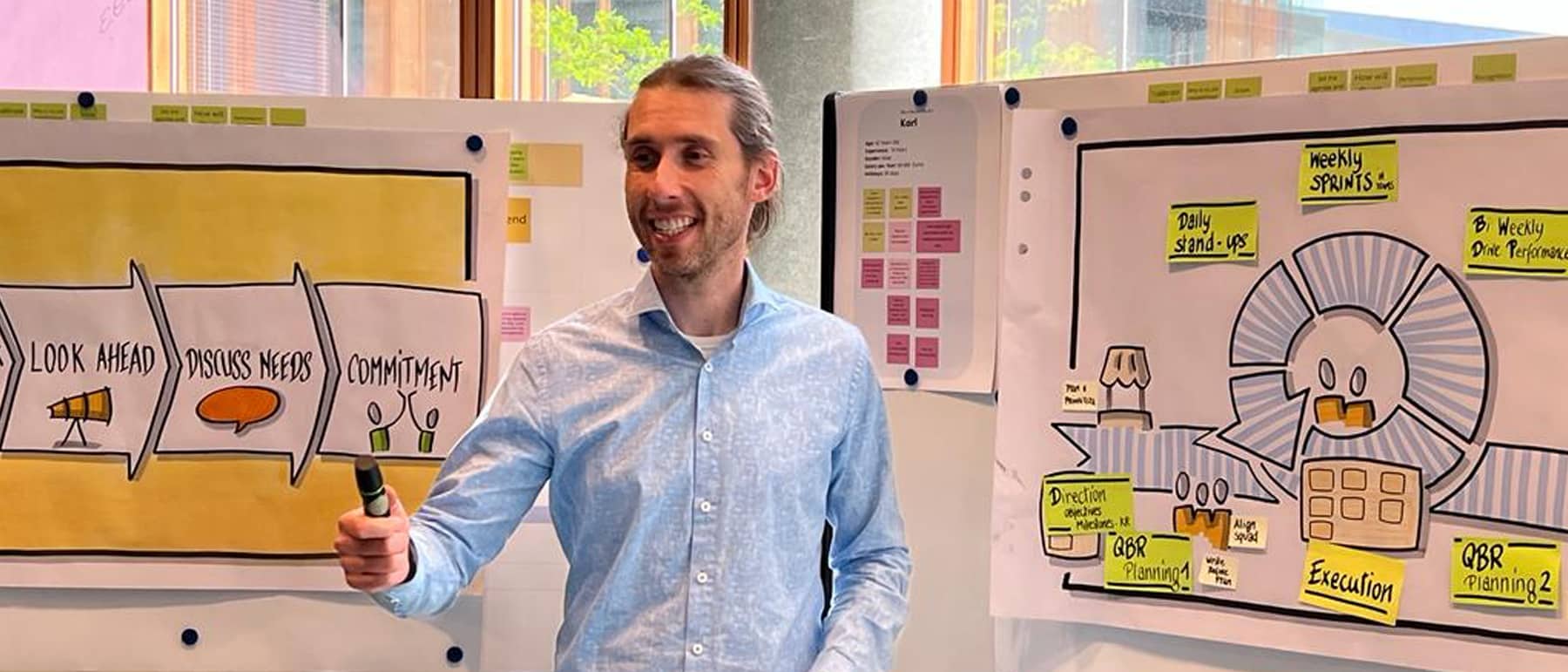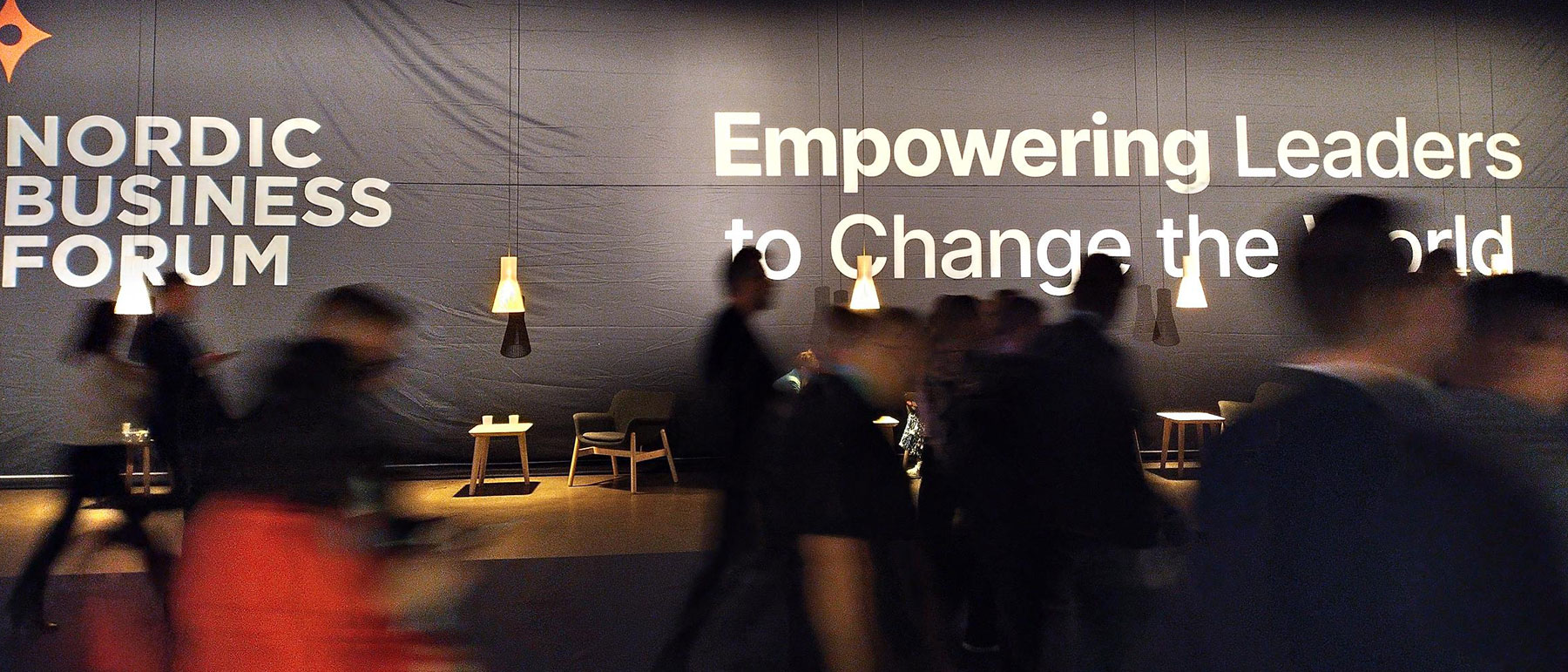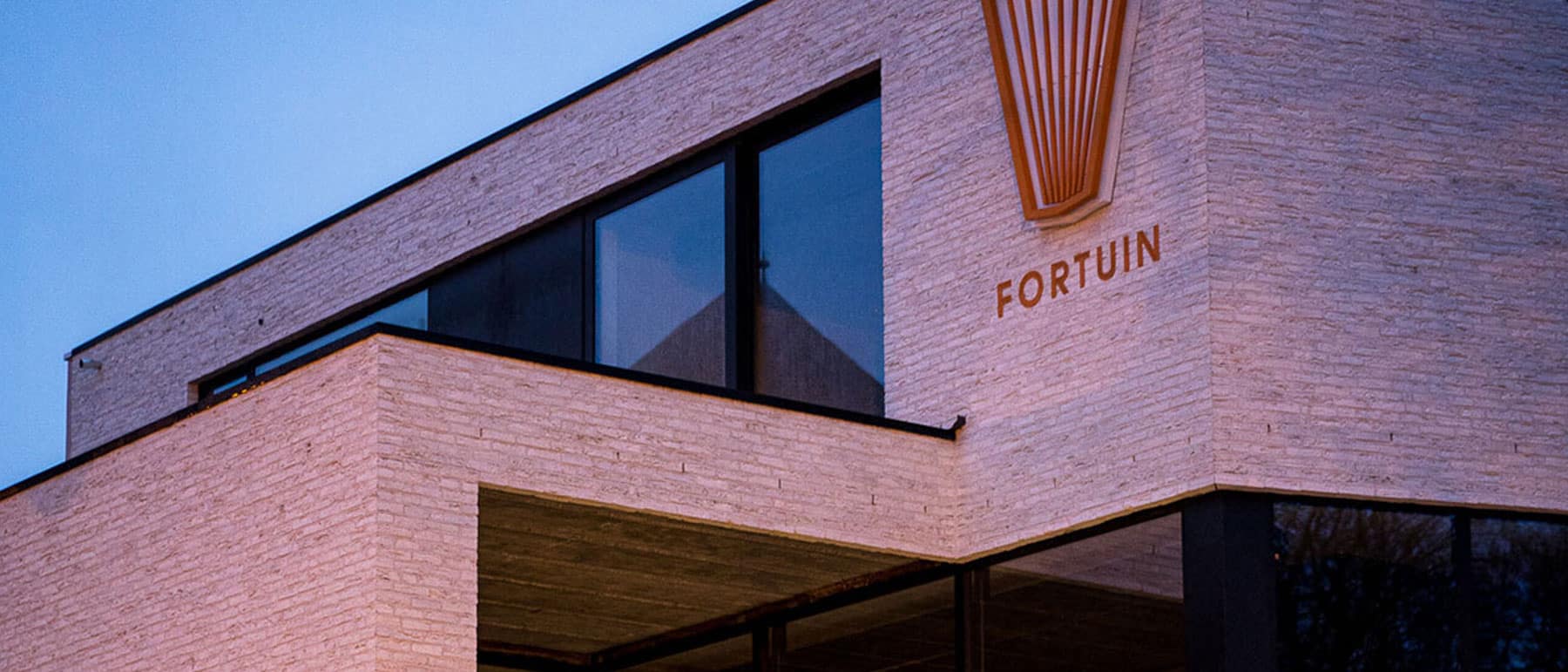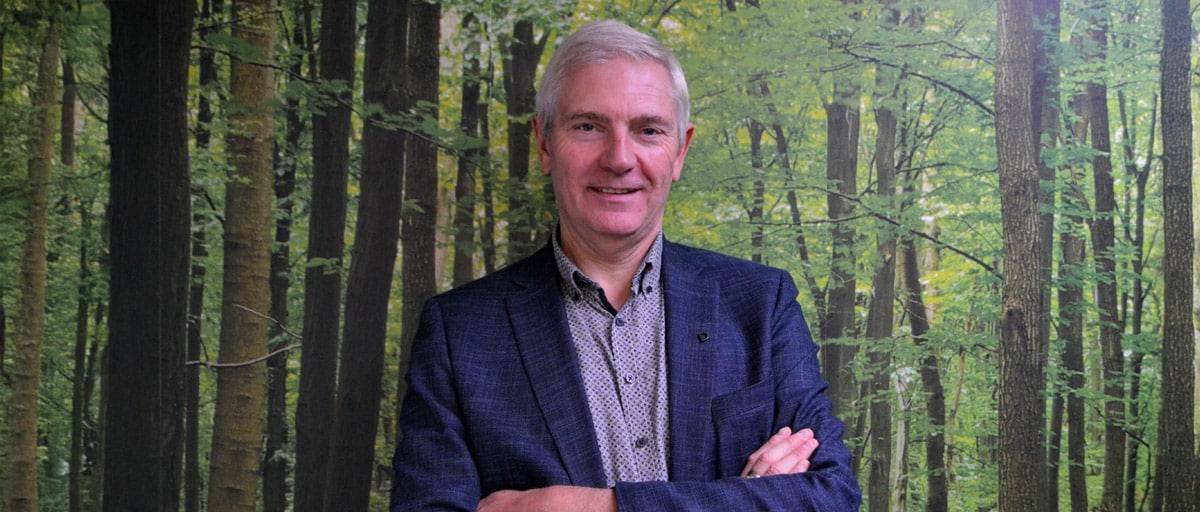Cockpit Conversation with Koen De Keersmaecker
Images for Moments that Matter
That’s what I discussed with Koen De Keersmaecker, visual facilitator and founder of Bizzuals. He guides teams through those crucial moments when words fall short—when what really matters is clarity, connection, and shared understanding. Visualization strengthens that shared understanding and accelerates decision-making (Eppler & Platts, 2009).
“Drawing,” says Koen, “helps to make clear what we’re actually talking about. In the end, everyone understands what was said. Because as you draw, you see it—and that changes everything.” This process works as a boundary object—a bridge connecting different perspectives within teams (Star & Griesemer, 1989).
Images in conversations that matter
Koen often works with leaders trapped in abstract language. “We talk about ‘strategy,’ ‘change,’ ‘culture,’ but nobody draws what that means,” he says. “And then you notice the conversation stays vague.”
As soon as you draw it or use an image, you see where things go wrong. Everyone looks at the same sheet—and literally, we get on the same page. This is a practical example of how visualization enhances alignment and collaboration (Morgan & Liker, 2006).
That’s what visualization does: it doesn’t beautify—it clarifies.
He uses visualisation for the conversations that count:
- when starting change programs where alignment is missing (Morgan & Liker, 2006),
- during projects where coordination falters,
- and in strategic or commercial meetings where decisions are made.
“Whether it’s with teams, boards, or clients, the power lies in looking together—not just talking.”
Bikablo and Obeya: structured clarity
Koen is a certified Bikablo trainer, a globally recognized method for visual communication. “Bikablo isn’t an art course,” he explains. “It’s a visual language you learn to speak. You use simple patterns, symbols, frames. They bring structure so everyone understands. It’s not about talent—it’s about technique and attention.” Structuring shared visual information makes change more efficient and helps insights stick (Mascitelli, 2020).
He also works with the Obeya concept—literally “big room” in Japanese—a physical or virtual space where everything connects: strategy, obstacles, progress. “In an Obeya, you see the whole picture. The walls tell the team’s story. People see where they stand, what others are working on, and what’s missing. That openness creates a culture of shared responsibility.”
From drawing to meaning
“Drawing is thinking,” says Koen. “But it’s also listening. When I draw during a conversation, you can feel the energy shift. People lean in, correct each other, add things. The image becomes common ground. And that sticks much longer than words.”
Participatory visualization creates strong shared ownership and group memory (Savioja et al., 2014).
His approach is radically participative. “I never draw for people; I draw with people. That way, insight doesn’t emerge afterward in a report—it happens during the conversation itself.”
The poster in the kitchen
Koen smiles when he repeats the phrase: “The poster in the kitchen—that’s proof of impact for me. It’s still hanging there weeks later. Everyone who walks in recognizes the story. New colleagues instantly get what’s going on. Then I know: this worked.”
He stresses that visualizations aren’t temporary. “Reports disappear into folders. But drawings stay alive. They invite. They provoke. They’re both conversation starters and agreements in one.” That’s exactly what makes visual tools so powerful for lasting organizational change (Star & Griesemer, 1989).
Stickers, symbols, and the language of images
Not every moment allows time to draw. “Sometimes the context doesn’t fit, or there’s no time,” Koen admits. “Then I work with prepared visual elements—stickers, symbols, icons—to still make the conversation visual. You put them on the table, move them around, combine them. That’s also visualization.”
He emphasizes that this way of working isn’t casual. “‘Quick and dirty’ doesn’t exist in my world. Either you learn to draw—for instance through Bikablo—or you work carefully with well-designed visual tools. Because those symbols mean something—they help thinking. You use them during the conversation to build shared understanding together.”
That precision, he says, is what makes the difference. “Visualization isn’t improvisation. It’s focus. You rearrange words until meaning becomes visible.”
From moment to momentum
According to Koen, visualization works not only during workshops but especially at the right moment. “It’s all about those moments that matter—decisive meetings, stalled change processes, teams that don’t understand each other. Those are tipping points. When you visualize there, you turn a single moment into momentum.”
He sees it every day. “After one session people say, ‘Now I see it.’ And that’s often literally true—they see for the first time where the problem lies, why the direction is off, or which step is missing.”
Visualization as a continuous compass
For Koen, a good image is more than a drawing—it’s a continuous reference point. “An organization needs a visual memory. That prevents having the same discussions over and over again. A good image is an anchor; it reminds people why they do what they do.” Visual models demonstrably act as a shared organizational memory (Eppler & Platts, 2009).
In his Imagineering Lab at Bizzuals, he brings people physically together around those images. “The walls hold stories, systems, strategies. We make it visible. When something is complex, we shouldn’t talk it out—we should show it.”
Lessons from the cockpit
The conversation with Koen struck a chord. At Add Business, I’ve worked for years with visualization in client conversations that matter. Together with Stefaan Ooms from Toughcrowd, I develop pitch visuals—simple, powerful images that make complex value tangible, often starting from a sketch.
But where we visualize at the moment of the client dialogue—the moment of truth—Koen starts one step earlier. He visualizes internally, before the first client is even approached. And he teaches it to the users themselves.
His method helps organizations prepare for those key moments—so conversations, meetings, and transitions become clear, efficient, and human. We meet in the same mission: to move beyond words. To create images of what matters—so that the essence doesn’t get lost in abstraction, but takes shape, literally and figuratively.
About Koen De Keersmaecker
Koen is a visual facilitator, trainer, and coach at Bizzuals, specializing in Business Agility, Lean Startup, and Design Thinking. As a certified Bikablo trainer and Obeya coach, he helps organizations bring clarity to transitions, strategies, and collaboration.
More about his work: bizzuals.com or bikablo.com or hello@bizzuals.com
References
- Eppler, M. J., & Platts, K. W. (2009). Visual representations in knowledge management: framework and cases. Journal of Knowledge Management, 13(6), 112–123.
- Mascitelli, R. (2020). Mastering Lean Product Development: A Practical, Event-Driven Process for Maximizing Speed, Profits, and Quality. Technology Perspectives.
- Morgan, J., & Liker, J. K. (2006). The Toyota Product Development System: Integrating People, Process, and Technology. Productivity Press.
- Savioja, P., Koskinen, H., & Lehtonen, T. (2014). Shared visualizations in participatory workplace design. CoDesign, 10(2), 120–135.
- Star, S. L., & Griesemer, J. R. (1989). Institutional ecology, ‘translations,’ and boundary objects: Amateurs and professionals in Berkeley’s Museum of Vertebrate Zoology, 1907–39. Social Studies of Science, 19(3), 387–420.
On attention, trust, and the art of leadership
Learning to see without certainties
During the Etion event at the Royal Museum of Fine Arts Antwerp, art, leadership, and humanity came together in a remarkable way. No management jargon, no frameworks or PowerPoints — just two voices speaking from experience, vulnerability, and conviction.
Carmen Willems, director of the KMSKA, shared the long journey toward the museum’s reopening — a process filled with delays, uncertainties, and expectations. “You have to be able to see it before it exists,” she said. Not only about the building, but about the people who make it real. About trust that has no proof yet. About the power of continuing to look, even when things aren’t finished.
Karen Donders, Director of Public Mission, Talent & Organization at VRT, complemented her story. She spoke about leadership under pressure and public scrutiny — about balancing control and release. “Leadership isn’t about controlling everything. It’s about daring to let go, while still being present.”
She described how her role often isn’t about making all the decisions, but about creating space for others to do so. Where Carmen spoke about vision and belief, Karen spoke about trust and proximity. Two perspectives that met — showing that real leadership doesn’t come from conviction alone, but from connection.
The silence that speaks
After the event, I lingered in the museum halls. My gaze stayed fixed on Two Walloon Peasant Children by Léon Frédéric. Two girls, sitting side by side, silently connected. No spectacle, no grandeur. Just calmness, simplicity, humanity.
It struck me because it showed something that often gets lost in leadership: the power of being present. And presence requires silence — just like art. That’s definitely a personal challenge in my own leadership 😊 Being present in silence.
From Canvas to Cockpit
What artists do closely resembles what good leaders do. They learn to see without certainties. They dare to question their own perspective. They build something that doesn’t yet exist, but which they sense will hold meaning.
In my work at Add Business, I try to do the same — only from the cockpit of organizations. I help entrepreneurs and teams sharpen their vision. Not by pushing harder, but by seeing better. By making visible the patterns that block growth.
The art of leadership
Perhaps that’s what this encounter at the KMSKA reminded me of: leadership is not a role or a function, but a way of seeing — of being present.
Just as art challenges us to look differently at what we think we know, good leadership challenges us to look differently at ourselves — and at the people we build with.
In that gaze, in that act of learning to see without certainties, real progress begins.
NBB HUB: Helsinki as Proof of Concept — Two Days, One Living Ecosystem
Helsinki as Proof of Concept: Two Days, One Living Ecosystem
The Nordic Business Forum in Helsinki was much more than an event. It became the moment where I could truly put my methodology to the test.
Walk your talk: the ultimate test
With Add Business, I step in as a co-pilot. With Companyonwise, I always start from DNA Discovery — the process of uncovering what truly drives organizations. I apply that same logic to myself. The connection between Brussels and Tallinn is no coincidence; it’s a deliberate strategy — to build a living ecosystem that helps Nordic and Baltic companies enter Belgium, starting from their own DNA.
But this had to be more than just a strong narrative. It had to be proven — in practice, at a single event. I had two days. No team, no luxury of preparation. Only the Brella app — a matchmaking platform that connects people based on shared profiles and interests — and one belief: if this methodology worked, I would be able to assemble a functioning ecosystem in 48 hours.
Growth, innovation, and digitalisation: the driving force of the ecosystem
During the Nordic Business Forum, a mosaic of connections came together in just two days. The network included professionals from software development, leadership, talent acquisition, legal, sales, branding, and education. Names like Timo Kempanen (Growth Agency), Kai Lempinen (Appmore), Lasse Kukkonen (Leadership Coaching), Lise-Lotte Laane (Sorainen), Juha Qvick (SalesFrame), and Mari-Liis Ahven (Optimist Public) represented more than business functions — they became the building blocks of an ecosystem connecting technology, people, and markets.
The result was not a loose collection of conversations, but a coherent network of fourteen complementary experts — each contributing their own strength: growth, innovation, digitalisation, human development, branding, legal expertise, and academic insight. Together, they form the essence of what NBB HUB stands for: a multidisciplinary, international alliance where knowledge, network, and practice reinforce one another to create sustainable market access.
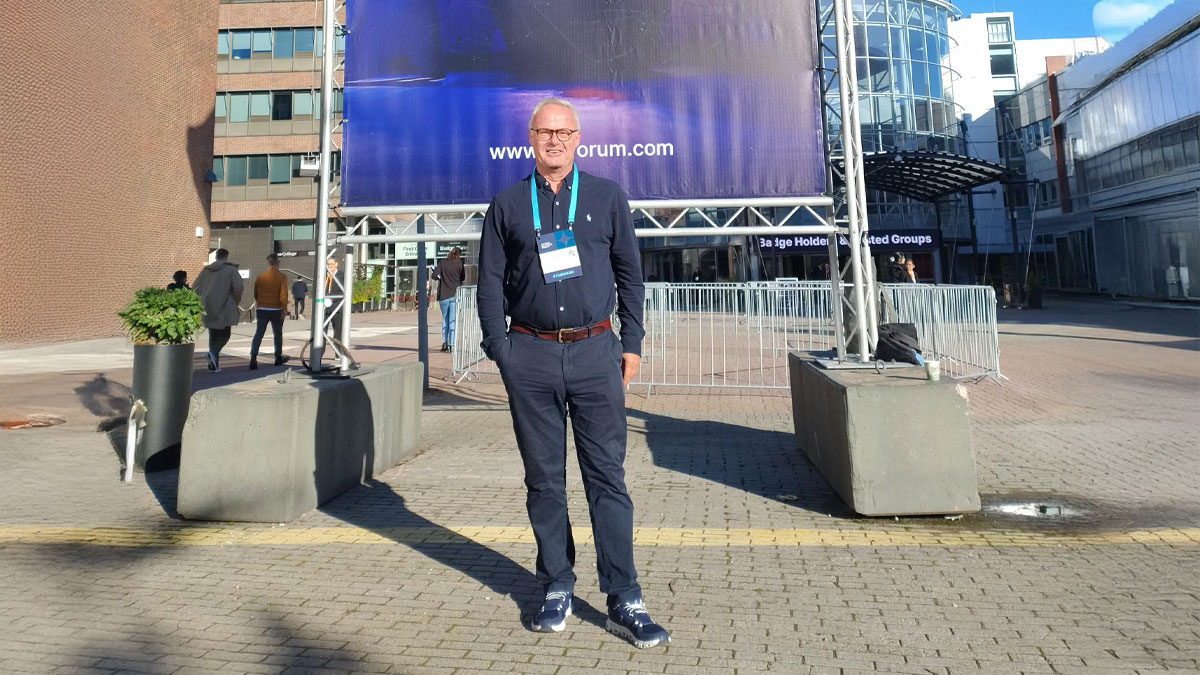
From markets to ecosystems: the bigger picture
When I founded NBB HUB, I — like many others — approached it through the lens of markets, data, and entry strategies: approaching companies, creating analyses, mapping out competition. Important, but incomplete. Modern businesses no longer operate in isolated markets, but in dynamic networks of collaboration and co-creation. This is even truer once those networks cross borders. Belgium is the perfect example: a country that seems complex at first glance, but whose diversity makes it a natural hub for European expansion.
Research confirms that business ecosystems — networks of organizations that cooperate and compete in the delivery of goods and services — are now critical for innovation, sustainability, and competitiveness (Espina-Romero et al., 2023).
But an ecosystem is much broader than just events. It includes universities and business schools (such as Vlerick, Solvay, and Antwerp Management School) that nurture talent and share knowledge; sector federations (like Agoria, Fevia, and essenscia) that represent their industries; and membership organizations (such as Voka and BECI) that unite thousands of companies. The art of internationalisation lies in knowing where these worlds intersect — and how to gain strategic access to them.
The human factor: DNA as a compass
This vision took shape for me last year when I met Lars-Erik Hion and Jana Kukk of Rethink on the same stage. Together, we mapped their organizational DNA — their authentic simplicity, their strength. That DNA became the foundation of their growth. Their story confirmed what I intuitively already knew: success in a new market doesn’t begin with data or strategy, but with identity. Companies that land successfully don’t come merely to find clients; they come to find partners who resonate with their DNA. That’s how sustainable ecosystems are built — from the inside out.
Theory becomes practice
The beauty of the NBB HUB narrative is that it is not based on theory to be tested later, but on real-time evidence. Helsinki became the proof of concept. I preach ecosystem thinking, I start from DNA Discovery, and I offer co-pilot guidance — and in Helsinki, I demonstrated that it works. In just 48 hours, I built a living ecosystem: fourteen professionals, six sectors, three countries. No spreadsheets, no reports — just practice that worked.
NBB HUB doesn’t operate from a distance but through proximity. Ecosystems are not static structures — they are living organisms. They grow, shift, and adapt. Their power lies in connection — exactly what Helsinki revealed.
References
- BCG Henderson Institute. Building Trust in Business Ecosystems. Boston Consulting Group, 15 September 2022.
- Espina-Romero, Laura C., et al. 7 Topics That Business Ecosystems Navigate: Assessment of Scientific Activity. Frontiers in Environmental Science 11 (2023).
- Rifa’i, A., Wibowo, A., & Kurniawan, A. Three Decades of Research in the Field of Business Ecosystem: A Bibliometric and Content Analysis. Cogent Business & Management 10, no. 2 (2023).
Ready to land in Belgium?
Discover how your company can land smoothly in Belgium — with a co-pilot who knows the terrain, the networks, and the fastest route to success.
Efficiency and Empathy: The Paradox of AI in Sales
Paradoxical Thinking as a Driver of Innovation
Paradoxical thinking invites us to embrace and combine apparent opposites into new insights, rather than choosing a single extreme (Lewis & Goldin 2015). By challenging participants not to choose between efficiency or empathy but to pursue both, a meaningful peer-learning atmosphere emerged: sales professionals shared concrete examples of how they balance AI with humanity.
1. The Productivity Paradox: Time Savings and Workload
AI promises time savings through automated prospecting, lead scoring, and reporting, but can increase workload as expectations and tasks multiply (Brynjolfsson & McAfee 2014). By setting clear boundaries with realistic KPIs and joint review sessions, teams can temper the productivity paradox and enhance job satisfaction.
2. Individual versus Organizational: Freedom and Control
Salespeople quickly discover convenient AI tools; organizations require governance, compliance, and data security (Mikalef et al. 2020). A paradoxical approach enables organizations to provide experimental space within clear policy frameworks, strengthening both innovation capacity and consistency.
3. Reach versus Value Creation: More Prospects and Deeper Relationships
AI increases the number of contact moments with prospects, but true customer value arises in personal follow-up and trust (Smith & Sprachman 2019). By refining segmentation criteria and defining measurable value metrics (e.g., Net Promoter Score), sales teams achieve both quantitative growth and qualitative customer satisfaction.
4. Preparation versus Authenticity: Data-Driven and Spontaneous
Data analysis and AI-supported scripts improve preparation for client conversations, but can make them feel artificial (Ransbotham et al. 2017). Paradoxical thinking encourages sales professionals to leverage AI-driven insights without losing their authentic voice, resulting in conversations that are both well-supported and genuinely human.
AI Makes Us More Human
By delegating routine tasks to AI, space is created for what distinguishes us: empathy, creativity, and judgment (Brynjolfsson & McAfee 2014). The real gain lies in combining digital intelligence with human connection, with AI serving as a catalyst for deeper customer relationships and innovation.
The Sales Professional of 2030
The future belongs to those who neither avoid AI nor rely on it blindly, but use it as an intelligent instrument to amplify fundamentally human talents. Only then can we create sustainable growth and meaningful customer relationships.
Bibliography
- Brynjolfsson, Erik, and Andrew McAfee. The Second Machine Age: Work, Progress, and Prosperity in a Time of Brilliant Technologies. New York: W. W. Norton & Company, 2014.
- Lewis, Michael, and Ian Goldin. “Paradoxical Leadership and Innovation.” Journal of Business Strategy 36, no. 2 (2015): 34–42.
- Mikalef, Patrick, Dimitrios Krogstie, Stephan Pappas, and Ole K. A. Mentz. “Investigating the Effects of Big Data Analytics Capabilities on Firm Performance: The Mediating Role of Dynamic Capabilities.” Information & Management 57, no. 2 (2020): 103–247.
- Ransbotham, Sam, David Kiron, Philipp Gerbert, and Martin Reeves. Reshaping Business with Artificial Intelligence: Closing the Gap between Ambition and Execution. Boston: MIT Sloan Management Review, 2017.
- Smith, Brian, and Michael Sprachman. “Human–AI Collaboration in Decision-Making.” Organizational Dynamics 48, no. 3 (2019): 100–109.
Cockpit Conversation with Gert van De Vijver: How One Tool Became the Cockpit of Growth
In the Cockpit
As a former operations manager at Alcatel and advisor to countless SMEs, he kept seeing the same pattern: strategies that never get executed, meetings without outcomes, and action points that disappear into thin air.
At forty, he shifted to interim management; at fifty-two, he made the leap to full-time entrepreneurship. His motivation: to bundle proven methodologies into one practical tool that turns meetings into a strategic engine.
The DNA of Too Doo: Focus on Meetings
Too Doo is not your typical project management platform. It deliberately starts from meetings to connect all facets of business operations. By preparing each meeting structurally, facilitating it tightly, and following up consistently, teams gain the tools to translate expectations into concrete actions and measurable results.
What does that mean in practice?
- Clear agendas and defined roles.
- Recording of decisions, action owners, and deadlines.
- Linking back to goals, KPIs, and strategic themes.
- One single source of truth instead of scattered notes, spreadsheets, and Teams channels.
From Chaos to Control
“Our ideal customer lives in chaos,” says Gert. Think of growing SMEs drowning in tools and scattered agreements. Too Doo centralizes that chaos, so the management team no longer needs to dig through eight different apps to keep the strategic line in sight. The result: less friction, more focus — and above all, visible progress.
AI as the Silent Co-Pilot
AI in Too Doo is deliberately positioned as an intelligent assistant, not a flashy gimmick. Think of:
- Automatic summaries of meeting transcripts.
- Monitoring of actions and early detection of deviations.
- Insight into where time actually goes (strategy vs. operations) — without losing human interpretation.
This allows a CEO to see, at a glance, where the team’s attention is going and make targeted adjustments.
From Freemium to Commitment
After dozens of demos each year with a conversion rate of around 10%, Gert realized: a demo alone doesn’t create lasting adoption. That’s why Too Doo now offers a freemium model with a diagnostic conclusion: after the trial period, users receive an in-depth analysis of their meeting behavior. Those “aha moments” form the foundation for a well-grounded collaboration — driven by data and behavior, not gut feeling.
Scaling Without the Consultancy Culture
The ambition: to scale sustainably without drifting into an expensive consultancy model. The strategy follows three tracks:
- Licenses as the backbone: software-first, supported by clear implementation standards.
- Implementation partners: an ecosystem of specialists helping organizations adopt the tool effectively.
- Methodical AI tools: built-in support for frameworks such as OGSM, RACI, or ISO — ensuring teams remain consistent as they grow.
In this way, Too Doo stays true to its core: using technology to strengthen collaboration, not replace people.
Lessons from the Cockpit
Meeting discipline is not an annoying obligation, but a lever for progress. Gert combines personal experience with academic insight to build a platform that seamlessly connects strategy and execution.
The First Customers: Effectuation in Action
The very first customers came through effectuation. Gert started with what he already had — his network, knowledge, and interim projects — and experimented with small-scale pilots among trusted contacts. By quickly delivering minimum viable implementations and keeping feedback cycles short, he built a foundation of enthusiastic references.
Growing Beyond Chance: Three Strategies
- Network expansion through referrals
Each pilot is turned into a case study and shared within industry groups to build credibility. - Differentiated product-service mix
After the freemium phase come modular add-ons such as advanced AI analyses and targeted workshops — creating clear upsell and cross-sell paths. - Partner ecosystem
By collaborating with specialized consultants and software vendors, Too Doo gains co-marketing opportunities and access to new segments.
With this approach, Too Doo moves beyond the randomness of early wins and builds a deliberate growth engine.
Conclusion
What if meetings were no longer seen as “lost time,” but as the cockpit for direction, focus, and execution? That’s the promise of Too Doo — one place where decisions, actions, and strategy converge, allowing teams to make progress that can be seen, measured, and celebrated.
Want to learn more or start a pilot?
Visit addbusiness.be or schedule an introductory call with Gert van De Vijver.
References (Selection)
- Davenport, T. H., & Harris, J. G. (2007). Competing on Analytics: The New Science of Winning. Harvard Business School Press.
- Kaplan, R. S., & Norton, D. P. (2008). The Execution Premium: Linking Strategy to Operations for Competitive Advantage. Harvard Business Press.
- Leonardi, P. M. (2014). Social Media, Knowledge Sharing, and Innovation: Towards a Theory of Communication Visibility. Information Systems Research, 25(4), 796–816.
- Mintzberg, H. (1979). The Structuring of Organizations. Prentice-Hall.
- Sarasvathy, S. D. (2001). Causation and effectuation: Toward a theoretical shift from economic inevitability to entrepreneurial contingency. Academy of Management Review, 26(2), 243–263.
- Vargo, S. L., & Lusch, R. F. (2004). Evolving to a New Dominant Logic for Marketing. Journal of Marketing, 68(1), 1–17.
